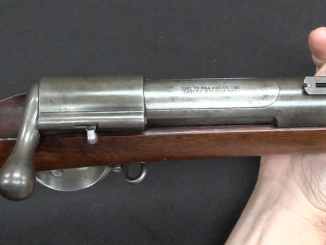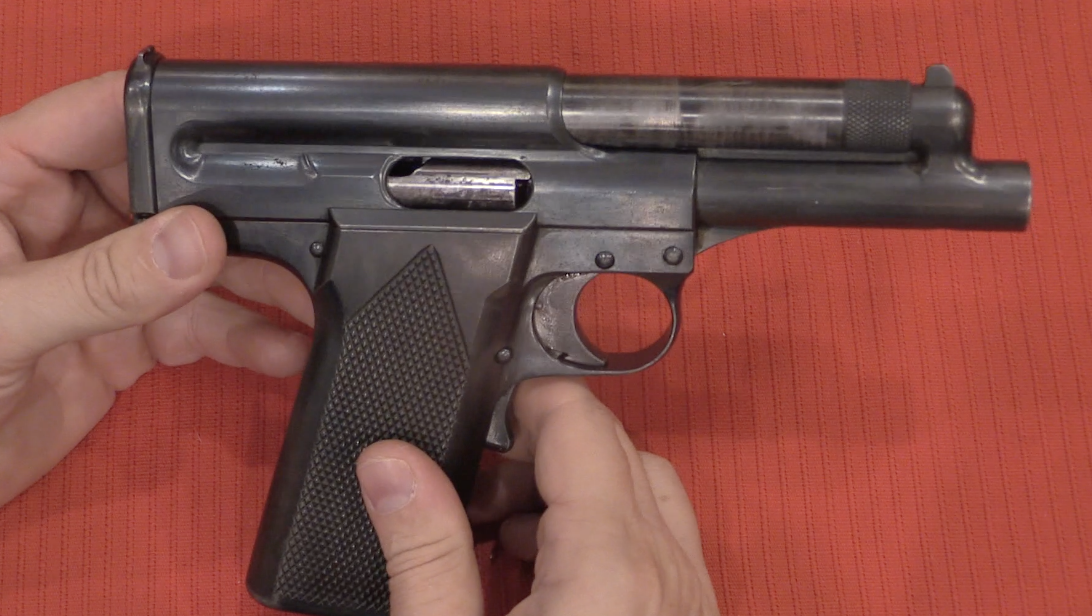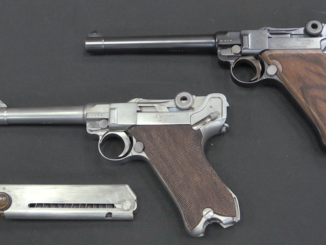The Porter was one of the few turret rifles ever put into serial production. Turret rifles are similar in principle to revolvers, but they is a cylinder with radial chambers (like the spokes of a wheel) instead of parallel chambers. Herein lies the potential problem: there is always a chamber pointing right back at you, the shooter. In an era of percussion guns that could occasionally chainfire, the notion of having a loaded chamber pointing at your face was less than appealing to most people. As a result, turret rifles (and pistols) never became successful designs.
The Porter, however, did see several thousand examples made. The last variant used typical percussion caps, but the first and second variants (including this second model Porter) used a quite unusual priming and firing mechanism. In addition, they and a wonderful design in which the entire side of the receiver opens up to make the action visible. This makes them much easier to understand, and very cool to look at!




I smell a potential Darwin Award for anyone who thinks of loading and firing this thing! In hindsight, the turret seems to be the not-so-great predecessor to the pan magazine (which is at least a hundred times safer to handle).
Beautiful machine work on that. I can see a problem in the rain- nothing keeping water out of the chambers. Also, has anyone ever tried regular roll caps in the Porter, or in a Sharps with a Maynard tape primer?
I’m a black powder guy, flint and cap, and I’m having trouble knowing what ignition system this rifle was supposed to feed. Any manuals still exist?
wow i now know how to shoot myself .thanks Ian,(3 times)
My best SWAG on the priming system is that it used a special pattern of cap, basically a “can” shape like a Colt revolver cap but closer to the size of a musket cap, minus the “flanges” at the bottom that gave the musket cap its sometimes used “top hat” nickname.
The triangle-like “pointer” on the disc rotor was the “follower” that shoved the caps around, like barrels rolling in a chute. Nine caps would take up about 3/4 of that circular space.
As the lever was worked, the follower would move about 1/12 of a circle (about 30 degrees, IOW) with each cycling, pushing a fresh cap around to firing position.
When the hammer dropped and fired the cap, it also held it in position, just like the hammer on a Colt or Remington single-action revolver.
When the lever was racked again, recocking the hammer, the spent cap was free to fall out that open port in the bottom, clearing the action for the next cap.
There almost certainly is a missing piece, as Ian said. My guess is it’s a small, curved leaf spring on the inside of the cap magazine lid, just above the fire hole. It would be anchored at the top, about 1 o’clock as you’re looking at it, and the free end would be at about 2:30.
It would be a friction spring designed to retain the caps against gravity but still allow the follower to push them down to its very tip, which would hold the cap for the hammer blow. After firing, the crushed cap would be “shortened” enough to slip past the end of the spring and fall out.
(There is a similar spring in the breech ring of any Colt revolver with the Thuer metallic cartridge conversion.)
As for firing with a “cant” to left or right, the pressure exerted by the next cap in line as the follower pushed it around to the fire hole should still have shoved the spent cap out.
As I said, this is just a SWAG. Take it for what it’s worth.
cheers
eon
Perhaps the caps were in a roll like a toy cap gun?
That is what the tape in a Maynard tape primer looks like. I have seen photos of it in Spencer’s book on the Sharps rifle.
Wouldn’t work. The nipple on a Maynard has to be where the flat cap on the roll can be crushed against it by the hammer. that would require the fire hole to be at right angles to where it actually is on this weapon.
a ring of caps, like on those eight-shot plastic toy revolvers you see at the dollar store, would work. Maybe a stamped ring of “cups” with fulminate in each one. The ring would be inserted and removed as one piece. To allow this, the indexing “pointer” would have to be a flip-up to allow the ring to be positioned under it.
cheers
eon
FWIW I like the the idea of a ring magazine that you put caps into. If the notch on the spring loaded cap follower has a function, it may be to index a pin on the magazine ring. Also, on the inside of the gun there are two dumbbell shaped features just to the rear of the flash hole which could be related. The flash hole seems canted as there are two drag rings on the cylinder. The main reason I like the magazine ring is the cumbersome nature of holding the follower back while fiddling the caps into the gun. After doing this, I’d probably shoot myself without waiting for a chain fire.
Non Colonel Colt seems to have played fast and loose with the truth on more than one occasion.
I feel the need to point out it would be ‘safe’ to shoot single loaded. Did anyone have a patent on the percussion cap harmonica design? Wondering if that was unavailable at some era forcing people to come up with the turret design. The lever indexing with a quickly removable harmonica would be rather handy.
If you moved the hammer and the cap feed to the underside of the stock like a “boot pistol” setup, and provided a vertical foregrip to keep the off hand down away from the front of the bar “magazine”, you wold have a rapid-fire rifle that could be reloaded very quickly if you had loaded spare “bars”.
As a bonus, the uncluttered top of the receiver would allow you to see the sights, or even allow mounting a telescopic sight.
Conversion to metallic cartridge would have been simple if rimfire was used. Centerfire would probably require a completely new searage, perhaps with an internal hammer striking from behind as on a Paterson revolving rifle.
Such a rifle might have been a viable competitor for the Henry/Winchester type tubular magazine lever gun.
cheers
eon
Did it’s lever action, have any similarities to later lever actions?
There are possibilities here with a keyed disc with kiddie caps, and a rotating shaft to index over the flash hole. My only trouble with black powder revolvers is the fired copper caps jam up the action. If used with proper paper cartridges, it all gets blown out down the barrel; no extractors or ejectors required.
Are you sure that the frame is cast? I would bet it is drop-forged.
Is the wheel not mutch to close, to the other parts, that an spark can squeeze past?
I have a book on the guns of the Smithsonian collection and it illustrates an earlier Porter with a (frankly terrifying) magazine in a turret above the breach. In the text, it also mentions two later variants; the first being a tape-primer, manually rotated .36; the second being a .50 cal with a pill-lock. Perhaps, then, the one in Ian’s video is a pill-lock gun? (The author also repeats the story about Porter being killed by his own gun.)
George Moller published a history of the models and the usage of Porter rifles in The Gun Report magazine, August 2008, pages 14 to 27. He mentions that you will sometimes see these rifles described as pill lock guns—they are not pill lock, they use conventional percussion caps loaded “upside-down.”
To prime the gun, first pull the side hammer to full cock. Then rotate the circular cover down to expose a clockwork mechanism. Rotate the follower and place the percussion caps in the groove mouth upward.
Here is Moller’s description after inserting the caps into his rifle: “. . . when the trigger is pulled, the falling hammer’s long nose enters the percussion cap’s open end, pushes the cap through a hole in the rear of the magazine, and detonates the percussion cap against the side of the receiver. The ignition spark passes through a small vent in the side of the receiver and a corresponding vent in the cylinder wall where it enters the chamber and ignites the powder charge. The percussion cap expands on detonation and falls away as the hammer is again cocked.”
The last variation of the Porter rifles did have conventional nipples on the side of the turret.
What if vent holes reduce chain fire risk?
With only 3 chambers loaded, it could be almost safe to fire !
The major risk of chainfire in a conventional percussion revolver is inadequate sealing of the chamber mouths. The flashover from the barrel-cylinder gap leaks past the bullet in the next chamber over, igniting the powder. This in turn ignites the next chamber, and so on around.
This can be dealt with by properly sealing the chamber mouths. In fact, this is one reason most cap-and-ball revolver bullet moulds “throw” a bullet that is slightly oversized, and why you get a ring of “shaved” lead when you ram the bullet home with a Colt or Remington-type creeping rammer. The bullet’s tight fit helps seal the chamber mouth against flashover.
The major risk of flashover in this weapon isn’t from the chamber mouths, which are almost too far apart around the wheel’s circumference for it to happen. It’s the far more dangerous setup of having nine flash holes close together around its hub with nothing preventing cap flash from reaching the holes either side of the one actually being fired.
If this arm did in fact use caps that were fired by a hammer that hit the inside of the cap (i.e., the cap was inverted relative to its usual position on a nipple), the chances of flashover are greatly increased.
While the head of the cap would “fail”, being blown through by the fulminate’s detonation and allowing the cap flash to reach the chamber, there would also almost certainly be a “fountain” effect around the firing pin, as much of the cap flash would be forced up past it to ricochet off the inside receiver wall and into the two immediately-adjoining open flash holes.
I suspect the low survival rate of these arms may be due to the number which experienced this effect. Not only would it almost certainly injure or kill the operator, there is a high probability that the firing of three or more chambers with at least one or two firing into the weapon’s mechanism would result it what the Royal Air Force used to euphemistically refer to as “catastrophic self-disassembly”.
cheers
eon
The man (Porter) was true inventor. Imagine how much “mid-night oil” he burned on this….
Anyway, my usual attention with these old guns is about the level and capabilities of manufacturing methods of those times – plain amazing.
Denny- I completely agree with your comments about manufacturing and quality. I had an 1884 trap door Springfield that I used to just hold and admire for the quality and detail of the metal work.
I am guessing the design of the cylinders has something to do with Colt’s Patents?
A standard revolving rifle that utilized a lever action may have been an interesting option? Albeit the burnt forearm problem.